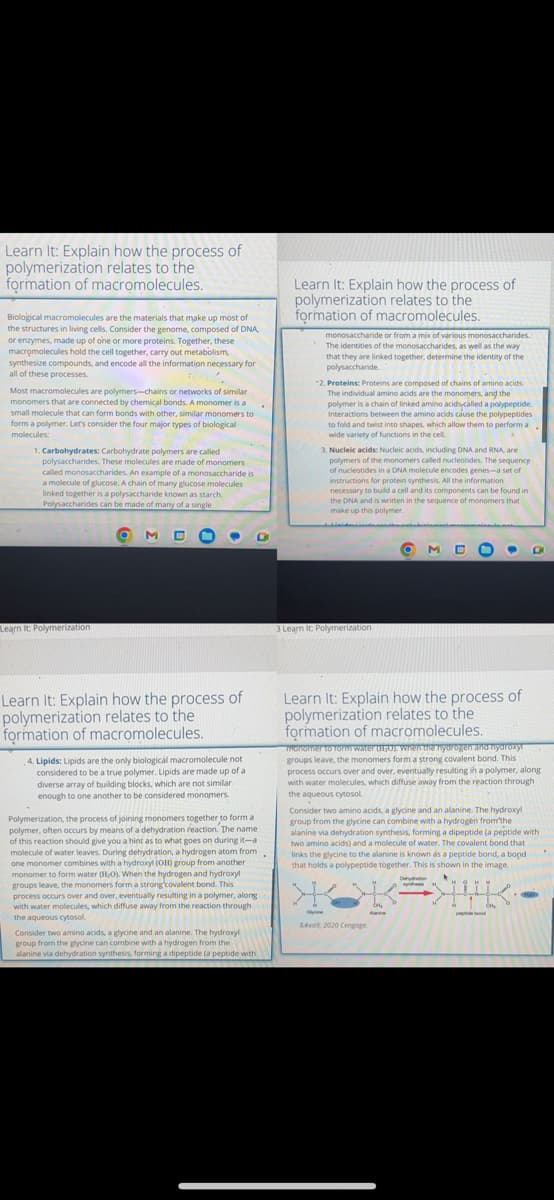Anatomy & Physiology
1st Edition
ISBN:9781938168130
Author:Kelly A. Young, James A. Wise, Peter DeSaix, Dean H. Kruse, Brandon Poe, Eddie Johnson, Jody E. Johnson, Oksana Korol, J. Gordon Betts, Mark Womble
Publisher:Kelly A. Young, James A. Wise, Peter DeSaix, Dean H. Kruse, Brandon Poe, Eddie Johnson, Jody E. Johnson, Oksana Korol, J. Gordon Betts, Mark Womble
Chapter3: The Cellular Level Of Organization
Section: Chapter Questions
Problem 4ILQ: Watch this video (http://openstaxcollege.org/l/ribosome) to learn about ribosomes. The ribosome...
Related questions
Question
Dehydration synthesis always results in the formation of which of the following?
A. Water
B. Protein

Transcribed Image Text:Learn It: Explain how the process of
polymerization relates to the
formation of macromolecules.
Biological macromolecules are the materials that make up most of
the structures in living cells. Consider the genome, composed of DNA,
or enzymes, made up of one or more proteins. Together, these
macromolecules hold the cell together, carry out metabolism,
synthesize compounds, and encode all the information necessary for
all of these processes.
Most macromolecules are polymers-chains or networks of similar
monomers that are connected by chemical bonds. A monomer is a
small molecule that can form bonds with other, similar monomers to
form a polymer. Let's consider the four major types of biological
molecules:
1. Carbohydrates: Carbohydrate polymers are called
polysaccharides. These molecules are made of monomers
called monosaccharides. An example of a monosaccharide is
a molecule of glucose. A chain of many glucose molecules
linked together is a polysaccharide known as starch.
Polysaccharides can be made of many of a single
Learn It: Polymerization
O M D
- C
Learn It: Explain how the process of
polymerization relates to the
formation of macromolecules.
4. Lipids: Lipids are the only biological macromolecule not
considered to be a true polymer. Lipids are made up of a
diverse array of building blocks, which are not similar.
enough to one another to be considered monomers
Polymerization, the process of joining monomers together to form a
polymer, often occurs by means of a dehydration reaction. The name
of this reaction should give you a hint as to what goes on during it-a
molecule of water leaves. During dehydration, a hydrogen atom from
one monomer combines with a hydroxyl (OH) group from another
monomer to form water (HO). When the hydrogen and hydroxyl
groups leave, the monomers form a strong covalent bond. This
process occurs over and over, eventually resulting in a polymer, along
with water molecules, which diffuse away from the reaction through
the aqueous cytosol.
Consider two amino acids, a glycine and an alanine. The hydroxyl
group from the glycine can combine with a hydrogen from the
ya
alanine via dehydration synthesis, forming a dipeptide (a peptide with
.
Learn It: Explain how the process of
polymerization relates to the
formation of macromolecules.
monosaccharide or from a mix of various monosaccharides.
The iden
identities of the monosaccharides, as well as the way
that they are linked together, determine the identity of the
polysaccharide.
2. Proteins: Proteins are composed of chains of amino acids.
The individual amino acids are the monomers, and the
polymer is a chain of linked amino acids called a polypeptide.
Interactions between the amino acids cause the polypeptides
to fold and twist into shapes, which allow them to perform a
wide variety of functions in the cell.
3. Nucleic acids: Nucleic acids, including DNA and RNA, are
polymers of the monomers called nucleotides. The sequence
of nucleotides in a DNA molecule encodes genes-a set of
instructions for protein synthesis. All the information
necessary to build a cell and its components can be found in
the DNA and is written in the sequence of monomers that
make up this polymer.
3 Learn It: Polymerization
Learn It: Explain how the process of
polymerization relates to the
formation of macromolecules.
monomer to form water (HO). Wisen the hydrogen and hydroxyl
groups leave, the monomers form a strong covalent bond. This
process occurs over and over, eventually resulting in a polymer, along.
with water molecules, which diffuse away from the reaction through
the aqueous cytosol.
MD O - C
Consider two amino acids, a glycine and an alanine. The hydroxyl
group from the glycine can combine with a hydrogen from the
alanine via dehydration synthesis, forming a dipeptide (a peptide with
two amino acids) and a molecule of water. The covalent bond that
links the glycine to the alanine is known as a peptide bond, a bond
that holds a polypeptide together. This is shown in the image.
Glycine
† Cengage
CH₂
Na
Dehydration
ap
><
CH₂
peptide bond
95
Expert Solution
This question has been solved!
Explore an expertly crafted, step-by-step solution for a thorough understanding of key concepts.
Step by step
Solved in 4 steps with 1 images

Recommended textbooks for you

Anatomy & Physiology
Biology
ISBN:
9781938168130
Author:
Kelly A. Young, James A. Wise, Peter DeSaix, Dean H. Kruse, Brandon Poe, Eddie Johnson, Jody E. Johnson, Oksana Korol, J. Gordon Betts, Mark Womble
Publisher:
OpenStax College

Biology (MindTap Course List)
Biology
ISBN:
9781337392938
Author:
Eldra Solomon, Charles Martin, Diana W. Martin, Linda R. Berg
Publisher:
Cengage Learning

Anatomy & Physiology
Biology
ISBN:
9781938168130
Author:
Kelly A. Young, James A. Wise, Peter DeSaix, Dean H. Kruse, Brandon Poe, Eddie Johnson, Jody E. Johnson, Oksana Korol, J. Gordon Betts, Mark Womble
Publisher:
OpenStax College

Biology (MindTap Course List)
Biology
ISBN:
9781337392938
Author:
Eldra Solomon, Charles Martin, Diana W. Martin, Linda R. Berg
Publisher:
Cengage Learning